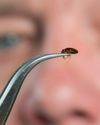
On 13 July 2017, the apocalypse hit Oregon and it looked like an almighty sneeze. A lorry had overturned and dumped its gooey cargo on a section of Highway 101. Slime covered the road surface, and a couple of vehicles got caught up in the gunk (see previous page). And as if that wasn't bad enough, the snot was teeming with hundreds of eel-like creatures: hagfish.
There are many outlandish life forms on the planet and then there is the hagfish. This ancient vertebrate tunnels its way through the carcasses of dead animals, feasting on their flesh. It has no jaws, a double row of pointy teeth, and very simple eyes. Yet these peculiarities pale in comparison to the hagfish's unique defence mechanism. Stowed away in their skin are slime glands from which the hagfish release a slime precursor. This is made up of molecules called mucins, and long, tightly coiled protein threads. When released, the mucins bind with seawater and expand, while the threads unravel in milliseconds. Together, they weave a textured slime that's tough enough to gag a shark, clog its gills and scare it away.
To stop itself becoming trapped in its own goo, the hagfish can tie a knot in its body and slide it from head to tail, wiping off the slime as it goes.
● Life of slime
If the hagfish is the champion of slime, the rest of creation comes in a close second. Microbes, plants, fungi and animals all use, produce and need slime for protection and defence, to move and mate, to communicate and catch prey. Even seemingly simple organisms have come up with ingenious slime solutions, whether they live on land or in the sea.
This story is from the {{IssueName}} edition of {{MagazineName}}.
Start your 7-day Magzter GOLD free trial to access thousands of curated premium stories, and 9,000+ magazines and newspapers.
Already a subscriber ? Sign In
This story is from the {{IssueName}} edition of {{MagazineName}}.
Start your 7-day Magzter GOLD free trial to access thousands of curated premium stories, and 9,000+ magazines and newspapers.
Already a subscriber? Sign In

TAKE IT SLOW
Slow running is a fitness trend with some hard and fast science behind it

Physics, AI and music share a common thread. You just have to know where to look
Studying science can lead you in many directions and open doors to unexpected possibilities along the way

BED BUGS VS THE WORLD
When bloodthirsty bed bugs made headlines for infesting Paris Fashion Week in 2023, it shone a spotlight on a problem that's been making experts itch for decades: the arms race going on between bed bugs and humans

Kids are the key to understanding obesity. But we need more of their genes...
We can unravel the role that bodyweight plays in disease, but we need a bigger, more diverse, sample of genetic material to do so

COVID inquiry: What did we learn and what can we do better in future pandemics?
Masks, social distancing, lockdowns... how effective was the UK's response to the COVID-19 pandemic?

One hormone could be the key that unlocks a cure for morning sickness
The nausea and vomiting that, in extreme cases, can endanger mothers and babies might soon be just a memory

THE WORLD'S WEIRDEST CREATURES
Under the sea and upon the land, some animals look - to us - pretty strange...

WHEN MIND AND MACHINE COLLIDE
First, Elon Musk wanted to make electric cars ubiquitous, then he wanted to make space exploration a private enterprise. Now, with Neuralink, his newest venture, Musk hopes to merge humans and artificial intelligence. Turns out, it might not be such a crazy idea...

COME OUT OF YOUR SHELL
Social anxiety is more than just being shy. It's a phobia born out of our evolutionary past. But that raises a puzzling question: why do so many of us fear human interaction when we're supposed to be the most sociable species on the planet?

SPACE ODDITIES
Take a tour of the weirdest spots in the universe, where the 'normal' rules don't apply. Places that squeeze time, blow bubbles and even rain glass... sideways